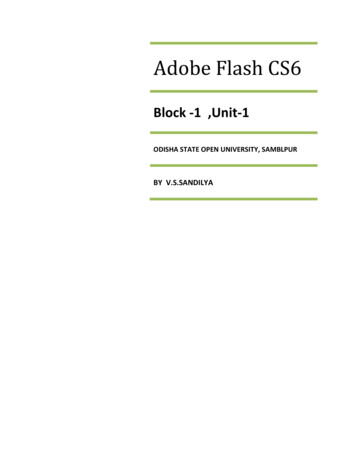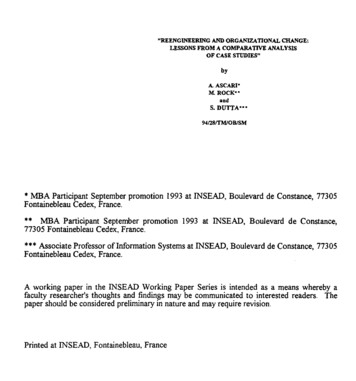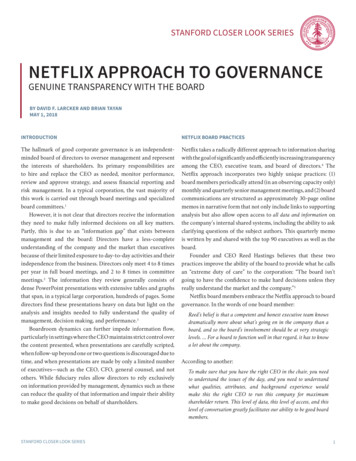
Transcription
INCLUDESDOWNLOADABLEWORKSHEETS &HANDOUTSRADICALLYOPENDIALECTICALBEHAVIOR THERAPYTHEORY and PRACTICE for TREATINGDISORDERS of OVERCONTROLTHOMAS R. LYNCH, P h D
Publisher’s NoteThis publication is designed to provide accurate and authoritative information in regard to the subject mattercovered. It is sold with the understanding that the publisher is not engaged in rendering psychological, financial, legal, or other professional services. If expert assistance or counseling is needed, the services of acompetent professional should be sought.Distributed in Canada by Raincoast BooksCopyright 2018 by Thomas R. LynchContext PressAn imprint of New Harbinger Publications, Inc.5674 Shattuck AvenueOakland, CA 94609www.newharbinger.comFigure 6.3, “Prototypical Emotional Expressions,” from Keltner, D., Young, R. C., & Buswell, B. N.(1997). “Appeasement in human emotion, social practice, and personality.” Aggressive Behavior, 23(5),359–374. Copyright 1988 by Wiley. Used with permission.Images in figure 6.5, “Polite Smile vs. Genuine Smile,” Vladimir Gjorgiev and Monkey BusinessImages/Shutterstock.Figure 6.12, “Subtle, Low-Intensity Social Signals Are Powerful,” from EMOTIONS REVEALED:RECOGNIZING FACES AND FEELINGS TO IMPROVE COMMUNICATION AND EMOTIONAL LIFE by Paul Ekman, copyright 2003 by Paul Ekman. Used by permission of Paul Ekman.Lines from “A Man and a Woman Arguing” from THE ESSENTIAL RUMI by Jalal al-Din Rumi,translated by Coleman Barks. Copyright 1997 by Coleman Barks. Used by permission.Illustrations on pages 163, 164, and 168 by Henrietta HellardCover design by Amy Shoup; Acquired by Catharine Meyers;Edited by Xavier Callahan; Indexed by James MinkinAll Rights ReservedLibrary of Congress Cataloging-in-Publication DataNames: Lynch, Thomas R. (Professor of clinical psychology), author.Title: Radically open dialectical behavior therapy : theory and practice for treating disorders of overcontrol /Thomas R. Lynch.Description: Oakland, CA : New Harbinger Publications, Inc., [2018] Includes bibliographical references andindex.Identifiers: LCCN 2017040500 (print) LCCN 2017042252 (ebook) ISBN 9781626259294 (pdf e-book) ISBN 9781626259300 (ePub) ISBN 9781626259287 (hardcover : alk. paper)Subjects: MESH: Behavior Therapy--methods Compulsive Personality Disorder--therapy Self-Control--psychologyClassification: LCC RC489.B4 (ebook) LCC RC489.B4 23 (print) NLM WM 425 DDC 616.89/142--dc23LC record available at 0 9 8 7 6 5 4 3 2 1First Printing
ContentsAcknowledgments viiKey Terms xiIntroduction 1Overview of Core RO DBT Tenets Overview of the Book’s Contents In RO DBT, Silliness Is No Laughing Matter 1Radical Openness and Disorders of Overcontrol 7Self-Control: Can You Have Too Much of a Good Thing? Basic Postulates of RO DBT Treatment Development and Efficacy Research 269707683Overview of Therapy Assumptions, Structure, and Targets 85RO DBT Core Assumptions Overview of Treatment Structure and Targets 5334666Assessment Strategies 69Assessing Overcontrol: A Conceptual Framework Common Errors and Problematic Assumptions The OC Diagnostic Protocol: Diagnosing Overcontrol, Step-by-Step Future Directions 471119A Neurobiosocial Theory for Disorders of Overcontrol 33A Novel Neuroregulatory Model of Socioemotional Functioning A Biosocial Theory for Disorders of Overcontrol Social Signaling: A Novel Mechanism of Change 31248688Maximizing Client Engagement 97Enhancing Client Engagement via the Physical Environment Enhancing Client Engagement via Orientation and Commitment Commitment Problems Unique to Overcontrol Enhancing Engagement Through Sequencing 97100137140
RADICALLY OPEN Dialectical Behavior Therapy6 ocial Signaling Matters: Micromimicry, Mirror Neurons,Sand Social Connectedness 145Social Bonds, Mimicry, and Mirror Neurons One Size Does Not Fit All Eye Contact The “Deer in the Headlights” Response Heat-Off Strategies Heat-On Strategies Therapeutic Use of Cooperative Social Signaling The Therapist as Tribal Ambassador Managing Maladaptive OC Social Signaling Tribe Matters 7 adical Openness and Self-Enquiry: Personal Practice,RTherapeutic Modeling, Supervision, and Team Consultation 177Openness Is Tribal Glue Openness, Collaboration, and Compliance Openness, Tribes, and Learning One Secret of Healthy Living Is the Cultivation of Healthy Self-Doubt What Is Radical Openness? Practicing Self-Enquiry and Outing Oneself RO DBT Team Consultation and Supervision Using a Consultation Team to Enhance Supervision and Treatment Outcomes 89The RO DBT Therapeutic Stance The Therapeutic Alliance Alliance Ruptures and Repairs 209211213Prevention of Premature Treatment Dropout 223Treatment Targeting and Intervention: Prioritizing Social Signaling 229230232233240257267270Dialectical and Behavioral Strategies 297Why Dialectics? Behavioral Principles and Strategies iv178180181184186190192198The Therapeutic Alliance, Alliance Ruptures, and Repairs 209Kindness First and Foremost Radically Open Living: Developing a Life Worth Sharing Structuring Sessions with the RO DBT Treatment Target Hierarchy Targeting In-Session Social Signaling: Basic Principles Monitoring Treatment Targets with Diary Cards Valued Goals, Themes, and Targets From Targeting to Intervention: An Overview of Treatment Strategies 10146149149151153155156161170175297327
Contents11Final Remarks, Practical Questions, and Treatment Adherence 371Some Commonly Asked Questions Final Remarks 371373Appendix 1: Assessing Styles of Coping: Word-Pair Checklist 377Appendix 2: The Clinician-Rated OC Trait Rating Scale 381Appendix 3: The Overcontrolled Global Prototype Rating Scale 385Appendix 4: RO DBT Semistructured Suicidality Interview 401Appendix 5: Targeting Indirect Social Signals: In-Session Protocol 405Appendix 6: Setting the Stage for Effective RO DBT Chain Analysis:In-Session Protocol 415Appendix 7: Using RO DBT Chain and Solution Analysis: Principlesand In-Session Protocol 419Appendix 8: RO DBT Adherence: A Self-Assessment Checklist 433Endnotes 451References 461Index 493v
AcknowledgmentsThis work could not have been accomplished without a tribe. I would like to begin bythanking our patients for their willingness to share their personal struggles andinsights—they have been my teachers and the raison d’être behind it all.However, without doubt, I am most grateful for the tremendous amount ofsupport, energy, and intellectual contributions made by my wife, best friend, and colleague Erica Smith-Lynch. Without her insight into human nature and willingness toquestion existing paradigms (most often those I held dearly), much of what is writtenwould not exist. Erica helped develop and refine the core philosophical premisesunderlying the treatment and was seminal in the development of novel therapisttraining methods, as well as new RO skills. Erica is the rock of RO DBT.I am also indebted to Roelie Hempel, who has been our research lab’s seniorscientist and associate director for the past 10 years. Her basic science background inpsychophysiology, her analytic brain, and her keen curiosity have been essential inour mechanisms of change research. She was the clinical trial manager for our MRCfunded multi-center randomized controlled trial and primary driver behind most ofour bio-behavioral and experimental research (and that’s just before breakfast). Roelieis the roll to Erica’s rock.Importantly, this work would also not be same without the time invested andgentle challenges made by Lee Anna Clark in helping refine and strengthen the neuroregulatory model that underlies the treatment—e.g. insights regarding optimal selfregulation, the importance of accounting for bio-temperament, and the utility ofundercontrol and overcontrol as multi-dimensional constructs. Finally, when it comesto core contributors, I am grateful for the wide range of intellectual and instrumentalcontributions made by Jennifer S. Cheavens during the early years of treatment development at Duke University—e.g., help with the development of new skills linked toopenness, flexibility, and forgiveness.In addition, I have been very fortunate to have been mentored by a number ofexceptional clinical academic researchers—five of whom I consider most influentialin the development of RO DBT. First, I learned most of what I know about radicalbehaviorism from Alan Fruzzetti—my PhD advisor at Kent State University. Alanintroduced me to Marsha Linehan, who trained me in standard DBT, and I wasgrateful when she also began collaborating with me in research—resulting in the firstmulti-site RCT of standard DBT funded by NIDA (PIs: Linehan, UW; Lynch, Duke).While this was going on, I was simultaneously running several other funded studies,including an NIMH K23 career development award that afforded me the opportunity
RADICALLY OPEN Dialectical Behavior Therapyof meeting and learning from two prominent psychiatric researchers—RangaKrishnan and Chip Reynolds. Ranga was the Chair of the Department of PsychiatryDepartment at Duke University Medical Center and a world-leading depressionresearcher. It would be impossible for me to outline all the ways Ranga encouraged,advised, and supported me during my tenure at Duke. He invited me to be part of anumber of large-scale initiatives including the NIMH funded Conte NeuroscienceCenter as a co-investigator, which is where I met Kevin LaBar and Greg McCarthyand started to work on models of depression that integrated brain and behavioralscience. It was also during this time that I met my other primary mentor for myNIMH K23 award—Charles (Chip) F. Reynolds—a world-leading clinical trial anddepression researcher who was located at the University of Pittsburgh’s WesternPsychiatric Institute. Chip somehow seemed to recognize something useful in me,because he spent an enormous amount of his valuable time helping me refine mygrant submissions and articles, including a visit to my clinic and lab at Duke accompanied by my NIMH program officer. One of the things I admire most about Rangaand Chip was how they managed their research teams and collaborations—alwayswith humility and openness to differing points of view.I am also grateful to a number of key influencers who have contributed in smalleryet powerful ways to RO DBT over the years. For starters, Sophie Rushbrook waspivotal in helping me formulate the final version of the skills manual and improvingour methods of training and supervision. Our dissemination work has become vastlymore sophisticated under the leadership of R. Trent Codd III and Jason Luoma. Plus,I am also enormously grateful to Jackie Persons for her perspicacious read of earlierversions of this book and encouragement to “find my voice” when describing RODBT rather than comparing it to others. Plus, the clinical observations and insightsmade by Christine Dunkley during the initial phases of our multi-site RCT wereseminal in helping me refine a number of key concepts and treatment targets. Duringthe early treatment development years, one of the most important influencers wasClive Robins. Clive was my primary clinical supervisor and research mentor duringmy clinical internship and postdoctoral training at Duke University. He was the yangto my yin—encouraging yet critical and challenging of my novel ideas. Similarly, thesupportive yet oftentimes challenging feedback from Martin Bohus helped me betterarticulate how RO DBT differed from standard DBT. Our work with eating disordersand subsequent empirical support has largely been due to the efforts and continuedenthusiastic support from Eunice Chen, Mimi Simic, Martina Wolf, and MarianTitley. A special thanks to Laura Hamilton and her team who have been instrumental in applying RO DBT in forensic settings. Plus, a note of gratitude goes out toRichard Booth and his research team who have been the driving force behind novelresearch testing the efficacy of RO skills alone approaches. I also wish to thank FrankKeefe, who was instrumental in the development and research of the RO loving kindness meditation protocol—whereby Frank obtained grant funding that allowed us torun a randomized controlled trial testing our LKM protocol and providing the empirical basis for adopting it in RO DBT.viii
AcknowledgmentsOf course, those mentioned above represent only a subset of all of the peopleinvolved in this work over the years. The remaining list is too long for me to describeeach person’s unique contribution—but suffice it to say the contributions were substantial, and I am grateful for each. These individuals include (and hopefully I havenot left anyone out): Zach Rosenthal, Linda Craighead, Ian Russell, Ben Whalley,Alex Chapman, Heather O’Mahen, Vanessa Ford, Linda George, Sue Clarke, DavidKingdon, Michaela Swales, John Beyers, Jim Carson, Leslie Bronner, David Steffens,Carl Lejuez, Dan Blazer, Steve Hollon, Mark Williams, Sarah Burford, KateTchanturia, and Bob Remington. In addition, I am also enormously grateful for theenthusiasm, energy, and feedback I have received from our ever-expanding tribe ofsenior clinician trainers, trainers-in-training, and supervisors from around the world;including Pip Thomas, Maggie Stanton, Nicole Little, Alex Fowke, Kristi Colwell,Lexi Giblin, Ann Gresham, Chris Kvidera, Michel Masler, Nate Tomcik, JimmyPortner, Karyn Hall, Kristen Fritsinger, Kirsten McAteer, Katrina Hunt, and AmyGaglia.I would also like to acknowledge the wide range of instrumental and intellectualinput, support, and new ideas generated from my prior students, postdocs, residents,and interns who I have mentored over the years, many of whom are now in seniorpositions, including; Kirsten Gilbert, Sara Beth Austin, Emily Vanderbleek, GuyMizon, Davina Wong, Kelly Cukrowicz, Moria Smoski, Sammy Banawan, LorieRitschel, Steven Thorp, Megan Barnsley, Dionysis Seretis, Prue Cuper, KristinSchneider, Ann Aspnes, Caroline Cozza, Daniel Dillon, Christine Vitt-Ferri, BethKrause, Tamar Mendelson, and Jen Morse.It is unlikely that our evidence base for RO DBT would be where it stands at thelaunch of the manual without noting the support I have been fortunate to havereceived over the years from a wide-range of external grant funding agencies, including NIMH, NARSAD, AFSP, MRC-EME (UK), Conte Neuroscience Centre (Duke),Centre for Aging (Duke), and the Hartford Foundation. In particular, my NIMHprogram officer, Enid Light, was exceptionally helpful in guiding me through thefunding maze during the earlier developmental years of RO DBT. Lastly, I am gratefulfor the editorial expertise, practical suggestions, and wit that helped make the finalproduct much improved—that being my senior editor, Xavier Callahan, as well as theoverall support from New Harbinger—in particular that of Catherine Meyers, ErinHeath, and Matt McKay. Their flexibility, experience, and belief in this work helpedme finally get it off the typewriter and out the door. I hope you enjoy reading the textand that you find the material beneficial.ix
Key Termsapproach coping: a strategy for reducing distress by engaging directly with its sourceor actively attempting to solve the problem that has triggered the distressbiotemperament: genetic and biological predispositions that affect one’s perceptionand regulation of emotions (compare trait)detail-focused processing: a style of integrating sensory stimuli that is characterizedby paying much more attention to the parts than to the whole (“missing the forest forthe trees”)dorsal vagal complex: the branch of the vagus nerve that is evolutionarily older andassociated with physiological and emotional shutdown, immobilization, and numbingof pain (compare ventral vagal complex)edge: in RO DBT, a term that refers to actions, thoughts, feelings, images, or sensations that we want to avoid, feel embarrassed about, or prefer not to admit to others(see also outing oneself; personal unknown)emotional leakage: the expression of emotion at higher intensity than one wouldgenerally feel comfortable exhibitingflat face: a facial expression devoid of perceptible emotionouting oneself: revealing vulnerability, fallibility, or one’s personal edge to someoneelse in order to locate the point where one’s personal growth can occur (see also edge;personal unknown)personal unknown: the far edge of psychological growth, where learning can takeplacesmuggle: the RO DBT therapist’s practice of introducing new information to a clientby planting a seed or a small part of a new idea, without telling the entire story, sothat the client has an opportunity to reflect on the information without feeling compelled to immediately accept or reject itsocial safety system: neural substrate associated with feelings of contentment, relaxation, and desire to affiliate (see also ventral vagal complex)
RADICALLY OPEN Dialectical Behavior Therapysocial signal: any action or overt behavior, regardless of its form, its intent, or theperformer’s awareness, that is carried out in the presence of another persontrait: a stable pattern of behavior moderated by biology as well as by the environment(compare biotemperament)turn the heat on/take the heat off: increasing or decreasing the amount of therapistattention—such as eye contact—directed toward a client in order to enhance clientengagement, provide opportunities for learning, or reinforce therapeutic progressurge-surfing: the practice of noticing but not acting on a compulsive desire or actionurge, and, instead, mindfully observing the compulsion or desire as it rises, crests,and falls away—like a wave—without trying to change itvalued goal: a personal objective that has emotional significance, is aligned withone’s core principles, and guides one’s actionsventral vagal complex: the branch of the vagus nerve that is evolutionarily newerand associated with feelings of safety and affiliation as well as with urges towardexploration (compare dorsal vagal complex)xii
IntroductionThis book presents a new transdiagnostic treatment, radically open dialectical behaviortherapy (RO DBT), which targets a spectrum of disorders characterized by excessiveinhibitory control, or overcontrol (OC). It is intended for clinicians treating clientswith such chronic problems as refractory depression, anorexia nervosa, and obsessivecompulsive personality disorder. Although the book can be read alone, it is best usedin tandem with The Skills Training Manual for Radically Open Dialectical BehaviorTherapy: A Clinician’s Guide for Treating Disorders of Overcontrol (T. R. Lynch, 2018),referred to throughout this volume as “the skills training manual.” In thirty lessons,the skills training manual presents twenty skills of radical openness (RO) along withclass exercises, user-friendly handouts and worksheets, and detailed notes forinstructors.Radical openness, the concept at the foundation of RO DBT, is a way of behaving. But it is also a state of mind informed by the central premise that emotionalwell-being involves the confluence of three features: openness, flexibility, and socialconnectedness. As a state of mind, radically open living involves actively seeking ourpersonal unknown in order to learn from an ever-changing environment. Radicalopenness also enhances relationships because it models humility and the willingnessto learn from what the world has to offer. As such, radical openness often requires usto sacrifice our firmly held convictions and self-constructs—and this is why the practice of radical openness can be painful.Overview of Core RO DBT TenetsRO DBT is supported by twenty years of clinical experience and translational researchthat parallels established guidelines for treatment development (Rounsaville, Carroll,& Onken, 2001). As a new treatment, it is both similar and dissimilar to itspredecessors.The decision to retain the terms dialectical and behavior therapy in the name ofthis new treatment reflects the desire to acknowledge two of its fundamental roots,but the retention of these terms should not be taken to mean that they represent RODBT’s only roots. Also influential in RO DBT’s development has been a wide rangeof philosophical, etiological, and treatment models and approaches, most notably dialectical philosophy and dialectical behavior therapy, mindfulness-based approaches,cognitive behavioral therapy, Gestalt therapy, motivational interviewing, basic
RADICALLY OPEN Dialectical Behavior Therapyemotion theory, affective neuroscience, personality and developmental theories, evolutionary theory, and Malâmati Sufism.The core tenets of RO DBT are as follows: We are tribal by nature. The survival of our species required us to developour capacities to form long-lasting social bonds, share valuable resources,and work together in tribes or groups. Psychological well-being involves the confluence of three factors: openness(receptivity), flexibility, and social connectedness. The term radical opennessrepresents the confluence of these three capacities, and radical opennessitself is the core philosophical principle and core skill in RO DBT. Social signaling matters. In disorders of overcontrol, deficits in prosocial signaling are posited to be the core source of OC clients’ loneliness. Core genotypic and phenotypic differences between groups of disordersnecessitate different treatment approaches.1 Overcontrol is a multifaceted paradigm involving complex transactionsamong biology, environment, and individual styles of coping. In people with disorders of overcontrol, biotemperamental deficits andexcesses make behavioral responses more rigid and thus less capable of flexible adaptation to changing environmental conditions. It takes willpower to turn off (that is, downregulate) willpower! Radical openness assumes that we don’t see things as they are but rather aswe are. One secret of healthy living is the cultivation of healthy self-doubt. Radical openness and self-enquiry are experiential and cannot be grasped onan exclusively intellectual basis. Therapists need to practice radical opennessthemselves in order to model it for their clients.Overview of the Book’s ContentsChapter 1 poses the question of whether there can be such a thing as too much selfcontrol, and it describes maladaptive overcontrol as well as its association withchronic and treatment-resistant psychopathologies. The chapter then establishes RODBT’s links to older evolutionary theory and more recent basic brain/behavioralresearch. It concludes with an overview of completed and ongoing clinical trialstesting the efficacy of RO DBT.Chapter 2 covers the rationale and basic science supporting the neurobiologicaltheory of OC disorders.2
IntroductionChapter 3 presents a step-by-step process for diagnosing disorders of overcontroland includes relevant measures for establishing a diagnosis.Chapter 4 gives an overview of RO DBT’s treatment structure, therapeuticstance, and global targets and includes a section on the assessment and managementof suicidal behavior in OC clients.Chapter 5 offers guidance on maximizing OC clients’ engagement by addressing(1) physical and environmental factors in the treatment setting, (2) strategies andprotocols for orienting clients to treatment and gaining their commitment, and (3)the timing and sequencing of interventions.Chapter 6 provides a detailed overview of core RO DBT principles that involvesocial signaling. The chapter includes information about how the therapist can usenonverbal social signals during treatment sessions as a way to maximize the client’sengagement and improve treatment outcomes.Chapter 7, in addition to presenting an overview of core RO and self-enquiryprinciples and strategies, discusses structural protocols for integrating RO principlesinto supervision or consultation and offers concrete illustrations of an ongoing selfenquiry practice.Chapter 8 gives a detailed description of RO DBT’s protocols for repairing ruptures in the therapeutic alliance. The chapter also discusses strategies for preventingclients from dropping out of treatment.Chapter 9 presents a step-by-step protocol for using OC themes to create individualized treatment targets that are linked to clients’ valued goals.2 The chapterincludes a clinical example of OC theme–based targeting to illustrate how muchsocial signaling occurs during a session and to show how the therapist can use his orher own nonverbal social signals to block the client’s maladaptive behavior andenhance the client’s engagement.Chapter 10 offers detailed descriptions of how RO DBT uses dialectical thinkingto guide the therapist’s behavior and facilitate new ways for the therapist to behavewith clients. Specifically, the chapter discusses the core dialectic in RO DBT: thejuxtaposition of compassionate gravity with playful irreverence. The chapter alsopresents an overview of core behavioral strategies in RO DBT, including informationabout using informal principles of behavioral exposure and using a detailed behavioral chain analysis.Chapter 11, with the aim of stimulating further research and dialogue, outlinessome future directions and implications of radical openness, both as a therapeuticconcept and as a way of being. The chapter also includes commonly asked questionsthat therapists can use to assess whether they are providing RO DBT–adherent treatment. (Appendix 8 offers a formal checklist to be used for the same purpose. It, likeall the appendices in this book, is available for download from www.newharbinger.com/39287.)3
RADICALLY OPEN Dialectical Behavior TherapyIn RO DBT, Silliness Is NoLaughing Matter*We take silliness very seriously in RO DBT because OC clients take life too seriously.For an OC client, relaxation and play can feel like hard work. Indeed, laughing andfrivolity are seen as staged performances for lost travelers on midnight ghost trainsspeeding through [Editor’s note: Stop! Cease! Desist! That is quite enough sillinessfor one page. We apologize for the author’s undignified ramble and assure the readerthat we requested—nay, demanded—a rewrite of this section and have carefullymonitored the author’s use of silly language throughout the remainder of the text. Weurge the reader not to squander any more valuable time perusing the paragraphs thatfollow and instead to get right down to work, starting with chapter 1. As the sayinggoes, business and hard work before pleasure and silliness—and we mean business!]In RO DBT, silliness is no laughing matter. Our OC clients are already tooserious. They compulsively work and strive to achieve long-term goals yet have forgotten how to relax, play, or join in with others. For an OC client, socializing can feellike hard work. [Author’s query: How am I doing so far?] [Editor’s reply: I’ve seenbetter.]The question is, why would silliness be therapeutic, especially since most adultswork hard to avoid appearing silly in front of other people? The quick answer is thatour avoidance stems from our deep-seated fear of being socially humiliated or ostracized. Yet if silliness is so feared, then why is it so common? Plus, why do so manypeople enjoy behaving in a silly manner, particularly when around friends? What isinteresting, when you take a moment to think about it, is that we make funny faces,use silly voices, and exaggerate our gestures when interacting with young children,not so much because we feel safe but because we intuitively recognize that acting sillywith kids helps them feel safe, which also makes it easier for them to learn, explore,and grow.Thus, regardless of your age, your silly behavior around another person, especiallywhen that person is in a power-down relationship with you—in a more vulnerablestate, for example, like a client in therapy—is an act of kindness and a powerfulsignal of nondominance, equality, and friendship. However, the best silly behavior—as any parent knows—is the kind that stems from the heart and is as much fun forthe sender of a silly social signal as it is for the receiver. The problem for those of uswho are no longer seven years old or younger is that having fun while being silly cansometimes be hard to do. The good news is that even cranky adults can learn to enjoybeing silly—it’s all about giving yourself permission, throwing yourself into the deepend, and then practicing again and again and again.* or, On the Importance of Being Absolutely, Positively, Indubitably, Superlatively, Incorrigibly,Unapologetically, Side-Splittingly, Over-the-Top, Spew-Coffee-Out-Your-Nose, Damn-the-TorpedoesSILLY4
IntroductionIt’s the same for our OC clients. They will not believe it is socially acceptable forthem to play, relax, or openly express emotions unless they see their therapists modelthat behavior first. That’s why, from time to time, you’ll see in the chapters aheadsome unusual language and text recommended by the association known as WritersAiring Silly Sayings Attributed to Unknown People (WASSA UP) that serves as thebest way to remind you—repeatedly, of course—of just how silly life can be. So watchout for WASSA UP! [Editor’s note: Heaven help us.]5
CHAPTER 1Radical Openness andDisorders of OvercontrolSelf-control—the ability to inhibit competing urges, impulses, behaviors, or desires,and to delay gratification in order to pursue distal goals—is often equated withsuccess and happiness. Indeed, failures in self-control characterize many of the personal and social problems afflicting modern civilization. Deficient self-control hasbeen linked cross-sectionally and longitudinally with a broad spectrum of problems,including substance abuse, criminal activities, domestic violence, financial difficulties, teen pregnancy, smoking, and obesity (Baumeister, Heatherton, & Tice, 1994;Moffitt et al., 2011), and significant portions of governmental spending and scientificresearch focus on understanding, preventing, and treating deficits in self-control.Self-Control: Can You Have Too Muchof a Good Thing?However, research shows that to
Overview of Core RO DBT Tenets 1 Overview of the Book’s Contents 2 In RO DBT, Silliness Is No Laughing Matter 4 1 Radical Openness and Disorders of Overcontrol 7 Self-Control: Can You Have Too Much of a Good Thing? 7 Basic Postulates of RO DBT 11 Treatment Development and Efficacy R










